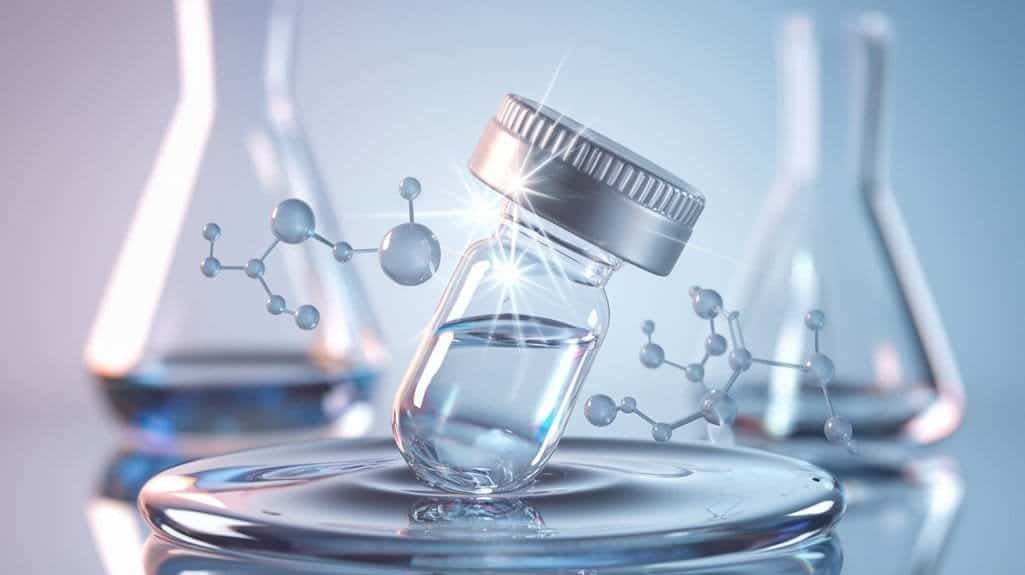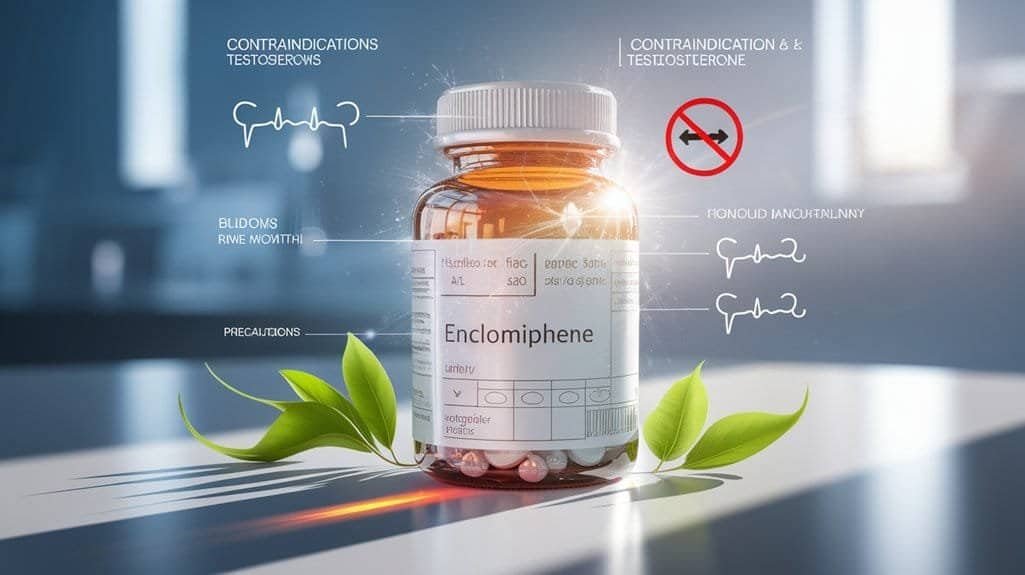Enclomiphene is a pioneering oral treatment for men's secondary hypogonadism that boosts testosterone levels without compromising fertility. It works by blocking estrogen receptors in the brain, leading to increased release of hormones that stimulate testosterone production. Unlike traditional testosterone replacement therapy, enclomiphene helps maintain spermatogenesis and has fewer side effects. Frequent monitoring of hormone levels and liver function is essential. For additional insights into its clinical applications and patient experiences, further exploration of the subject can be beneficial.
Key Takeaways
- Enclomiphene is a testosterone treatment for men with secondary hypogonadotropic hypogonadism, offering an alternative to traditional testosterone replacement therapy.
- It helps increase serum total and free testosterone levels while preserving fertility by stimulating spermatogenesis.
- Common side effects include headache and nausea, with serious risks such as deep vein thrombosis.
- Dosages typically start at 12.5 mg or 25 mg, with ongoing monitoring of hormone levels crucial for efficacy and safety.
- Enclomiphene has a favorable safety profile compared to clomiphene and maintains reproductive health while improving symptoms like fatigue and low libido.
Mechanism of Action

Although enclomiphene primarily targets estrogen receptors, its mechanism of action considerably influences testosterone production.
By blocking these brain receptors in the hypothalamus, enclomiphene prevents estrogen from binding, disrupting the normal negative feedback loop. This disruption stimulates a rise in gonadotropin-releasing hormone (GnRH), which in turn accelerates the pituitary gland's release of luteinizing hormone (LH) and follicle-stimulating hormone (FSH).
Elevated LH particularly activates Leydig cells in the testes, leading to increased testosterone synthesis. This process fosters hormonal balance, as enclomiphene enhances the body's natural testosterone levels without external supplementation. Clinical studies have shown that this medication can produce substantial increases in testosterone levels, making it a valuable alternative to traditional testosterone therapies.
Unlike traditional therapies, it preserves hypothalamic and pituitary function, ensuring that sperm production and fertility remain intact while managing hormonal equilibrium effectively.
Indications and Uses
Enclomiphene is primarily indicated for treating men with hypogonadism, particularly those with secondary hypogonadotropic hypogonadism. This treatment targets patient profiles who exhibit low testosterone levels attributable to deficiencies in the hypothalamic-pituitary-gonadal axis.
It notably raises serum total and free testosterone, offering an alternative to traditional testosterone replacement therapy for those aiming to stimulate their endogenous production.
In addition, enclomiphene effectively addresses symptoms such as fatigue and diminished libido while simultaneously enhancing male fertility by improving sperm count, motility, and morphology. This makes it suitable for men concerned about fertility while treating low testosterone.
Ultimately, enclomiphene aligns with specific treatment goals tailored to individual needs, presenting a nuanced option within the therapeutic landscape for hypogonadism.
Adverse Effects

When considering enclomiphene, it's essential to be aware of its potential adverse effects. Common side effects, like headache and nausea, occur in a small percentage of patients, while serious side effects, though rare, can include deep vein thrombosis and pulmonary embolism. Careful monitoring is recommended, especially for those with pre-existing conditions or who are taking blood thinners. Additionally, the antiestrogenic properties of enclomiphene may contribute to its varied side effect profile compared to traditional testosterone therapies.
Common Side Effects
Testosterone therapy, which includes the use of enclomiphene, can lead to various side effects that may affect users differently. Understanding side effect frequency is significant, as patient experiences often vary.
Common side effects include:
- Headache (1.6%)
- Nausea (1.0%)
- Mood swings, including irritability
You might encounter physical symptoms such as headache and nausea, alongside psychological manifestations like mood swings and fatigue, all of which have reported frequencies.
Hormonal impacts like increased hematocrit and appetite and even notable concerns such as erectile dysfunction may also arise.
Maintaining awareness of these potential side effects can assist in managing your overall health and discussing concerns with healthcare providers, ensuring informed decisions in your treatment journey.
Serious Side Effects
While many users of testosterone therapies may benefit from the treatment, serious side effects can pose significant health risks. Awareness of these adverse effects, particularly cardiovascular risks and neurological effects, is essential.
| Side Effect | Incidence Rate | Medical Action Required |
|---|---|---|
| Deep vein thrombosis | 0.2% | Immediate medical intervention |
| Difficulty breathing | N/A | Emergency response |
| Blurred vision | 0.5% | Consultation with eye specialist |
| Dizziness | 0.7% | Assessment and possible treatment |
Serious conditions such as pulmonary embolism and ischemic stroke occur rarely but exemplify the risks. Monitor for symptoms like swelling or severe headaches, as these may signal severe reactions requiring prompt attention.
Monitoring Recommendations
Awareness of serious side effects prompts the need for vigilant monitoring during enclomiphene therapy.
You should prioritize specific monitoring parameters to guarantee safety and efficacy. Regular assessments of testosterone, estrogen, LH, and FSH levels are essential for detecting hormonal imbalances.
Additionally, keep track of liver function tests (ALT and AST) to identify potential hepatic concerns early. It's also important to monitor cardiovascular risk factors like lipid profiles and blood pressure.
- Monitor hormone levels for treatment efficacy and adjust dosages as needed.
- Conduct regular liver function tests to prevent severe complications.
- Track cardiovascular risk indicators to manage overall health.
Maintaining patient compliance with these monitoring protocols is critical for achieving optimal treatment outcomes.
Dosage and Administration
When considering the dosage and administration of enclomiphene, starting with a low dose, such as 12.5 mg or 25 mg, is essential for evaluating individual tolerance.
Dosage can be tailored to your specific needs and goals, and if tolerated without serious side effects, adjustments can be made.
Enclomiphene is taken orally in tablet form, either with or without food; however, taking it with a small meal may mitigate potential nausea.
Consistency is imperative; take the tablets at the same time each day to maintain stable blood levels. Daily administration is recommended, and regular monitoring of hormonal markers is crucial to assess treatment progress.
Different formulations, including sublingual options, may offer additional flexibility in an individualized treatment plan.
Contraindications and Precautions

Understanding the contraindications and precautions associated with enclomiphene is essential for ensuring patient safety and optimizing treatment outcomes. A thorough contraindications overview reveals key populations who should avoid this medication:
- Pregnant or breastfeeding women
- Patients with a history of liver disease
- Individuals with unexplained uterine bleeding or ovarian growths
Precautions emphasis is critical in the context of pre-existing conditions, including a history of blood clots, cardiovascular disease, or uncontrolled endocrine dysfunction.
Furthermore, be vigilant for potential drug interactions with medications like blood thinners or those affecting liver function.
Close monitoring for adverse events, particularly indicating thromboembolic risks, is crucial. Always report any unusual symptoms to your healthcare provider promptly to mitigate complications.
Clinical Trials and Approval Status
Clinical trials of enclomiphene have demonstrated its potential as an effective treatment for men with secondary hypogonadism.
In prospective, randomized, blinded Phase 2 and 3 trials, 953 men were administered enclomiphene citrate, leading to a significant median increase of 166 ng/dL in total testosterone levels.
These clinical trial results indicate comparable treatment efficacy with topical testosterone and clomiphene citrate, while optimizing luteinizing hormone and follicle-stimulating hormone production.
Importantly, enclomiphene exhibited a much lower incidence of adverse events than clomiphene, supporting its safety profile.
Additionally, enclomiphene preserved spermatogenesis, maintaining testosterone production without the detrimental effects typically associated with testosterone replacement therapy, making it a compelling option for managing secondary hypogonadism.
Frequently Asked Questions
How Long Does It Take to Feel the Effects of Enclomiphene?
You'll likely feel noticeable effects within two to four weeks, though individual variations can influence this timeline. Consistent treatment and monitoring are essential to optimize your response and manage any lingering symptoms effectively.
Can Women Use Enclomiphene for Hormonal Issues?
Yes, women can use enclomiphene for hormonal issues. It effectively promotes hormonal balance, supporting women's health by improving ovulatory function, enhancing fertility, and addressing hormonal disruptions related to conditions like Polycystic Ovary Syndrome (PCOS).
Is Enclomiphene Addictive or Habit-Forming?
While enclomiphene's safety profile demonstrates no clear appetite for addiction potential, it's essential you monitor usage to mitigate side effects. Understanding its effects empowers you to navigate treatment effectively and responsibly.
Can Enclomiphene Be Used for Bodybuilding Purposes?
You can use enclomiphene for bodybuilding to promote muscle growth and enhance performance. By increasing testosterone levels, it stimulates muscle protein synthesis, leading to improved strength and recovery, essential for rigorous training regimens.
What Lifestyle Changes Can Enhance Enclomiphene's Effectiveness?
To maximize effectiveness, you'll need strategic dietary adjustments and tailored exercise routines. Optimize nutrient intake while engaging in regular, targeted workouts. These changes can greatly enhance overall health and hormonal balance, elevating your results.






